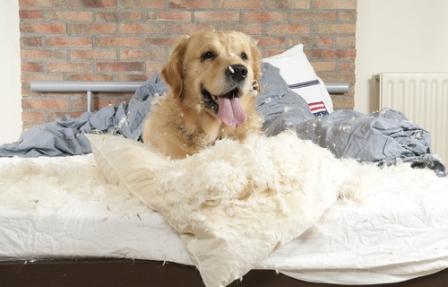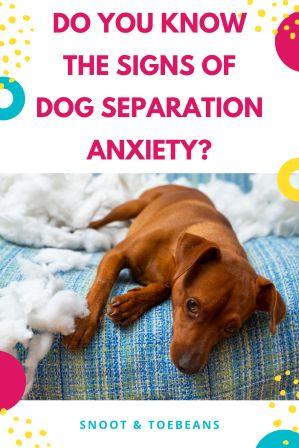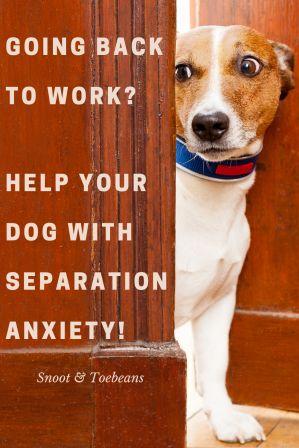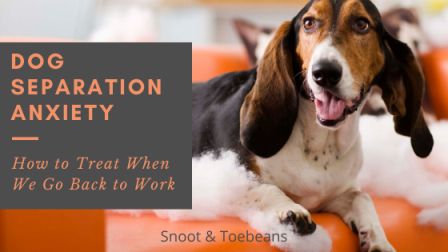Disclosure: My dog blog is supported by dog parents just like you. I only recommend products that I would use on my dogs. All opinions expressed here are my own. I sometimes earn a small affiliate commission, at no extra cost to you, when you click through the affiliate link and purchase something. You can read more about my affiliate policy here.
I bet you and your dog have gotten in some major bonding time over the past two months. I know, because I have been bonding with my two doggos. For our fur kids, having us home 24/7 has been a dream come true. However, now is the time to put a plan in place to treat dog separation anxiety.
By doing so, we can help avoid stress for our doggos when we go back to work. In addition, we will be avoiding stress for ourselves. Nobody really knows how dogs will react when we go back to normalcy, because this is a first.

However, there might be a direct relationship between dog separation anxiety and pet parents returning to work. This will especially be true for doggos who previously suffered from mild to more severe separation anxiety.
Furthermore, even doggo’s who were once treated successfully could be at risk of dog separation anxiety. Due to shelter in place orders, many people adopted or fostered doggos from shelters or rescues. Therefore, these dogs could be at risk, too! In other words, some of them have never been left home alone since being adopted or fostered.
Likewise, many of our doggos who have never had separation anxiety issues, could be at risk. Why? A sudden change in routine can be hard to adjust to. As a matter of fact, change isn’t easy for us humans either.
What Does Dog Separation Anxiety Look Like?

Dogs might react to a sudden change in schedule by showing different separation anxiety signs. Possible signs to look for:
- whining, barking, and howling beyond the normal response to noises outside
- scratching at doors and windows
- digging in the carpet
- chewing inappropriate items such as furniture and baseboards
- if crated, chewing on crate and signs of trying to escape it
- potty accidents, although housetrained
- excessive drooling and/or panting
- a change in appetite, such as overeating or not eating at all

One would think that a dog will eventually figure out that their parents WILL return. And, as a result, the anxiety will ease all by itself. Unfortunately, this is not the case. Nobody really knows what these doggos are thinking. But, one thing is for sure, they act as if their parents will never ever return.
In addition, if separation anxiety is left untreated, it often worsens with more time. As we start to transition back to our pre-quarantine lives, there are some things we can do.
How to Help Your Dog With Separation Anxiety
“For the dogs who are very people oriented, they’re going to have a tough time when we switch to working normal eight hour days. Most pets don’t like sudden and abrupt changes. Instead, try starting now to get your pet ready and ease them back to your previously ‘normal’ routine more easily.”
Janelle Metiva, dog behavior specialist with Best Friends Animal Society LA
To get dogs prepared for a little more alone time once again, Metiva suggests theses steps:
- Create a safe, comfortable place where they can have peaceful, relaxing alone time. This could be a crate or separate room; just make sure it’s the quietest part of the house.
- Provide them with enrichment that can be enjoyed independently, such as hidden treats in boxes, food puzzles, stuffed Kongs, etc.
- Play soothing music, such as reggae, smooth jazz, classical, or play the TV or radio on stations like the BBC or NPR, while you’re gone. This will keep them from being startled by outside noises. You can also try a white noise machine.
- Reward your dog for calm, independent behavior (especially if they’re usually clingy). We tend to pay attention to dogs only when they’re active or even misbehaving. They should be rewarded for being calm and chill.
- Practice leaving for short periods of time to run essential errands or go for a walk:
- If your dog shows signs of panic, decrease the amount of time that you leave, even if for just a few seconds.
- When your dog barks or paws at the door as you leave, come back only when they’re quiet.
- If your dog has trouble being alone for even brief periods of time — consult a Certified Separation Anxiety Trainer (CSAT) who usually does virtual consultations.
So, with a plan in place, you will help avoid stress for both you and your dog. You will be able to go back to work with peace of mind.
To Sum Up
In short, each dog will respond differently to the treatment solutions mentioned above. For instance, some will respond to having their unique sensory perceptions appealed to. While others will respond to olfactory games or soothing music.
Therefore, you may have to try several solutions to figure out what will work best for your doggo. Furthermore, there is no guarantee that any of the solutions will work. Most importantly, speak with your veterinarian for guidance.
There is a lot of good information online, so do some quality researching. In addition, there are online courses you can take. One such course is Mission: Possible, An Online Course for Guardians. This is an informative online training that includes medical-professional interviews and tools you can download.
I do not make any money from sharing the link above or if you happen to purchase the course. Purchasing the course is something I personally plan to do to help me with my two doggos.
You might enjoy one of our Dog Chef recipes to use when rewarding for dog separation anxiety techniques.
You can use one of the following images to pin to Pinterest.





